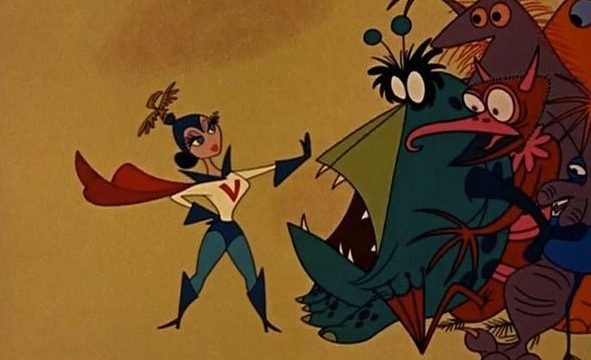I suppose one of the things we lose when we explore the greater universe is the more bonkers style of science fiction. This is a shame; I deeply love bonkers science fiction. Much more than hard science fiction, honestly, which has never truly appealed. This episode of what was at the time Disneyland kind of tries to have it both ways, featuring as it does both Wernher Von Braun and Edgar Rice Burroughs. But it’s really sort of “this is what people used to believe life on other planets could be like, and this is what we now believe life on other planets could be like” despite not having any real evidence that there was life on those other planets to begin with. So it’s all ridiculous fun, even when they’re being serious.
The episode starts with Walt and his “friend,” Garco the robot. Because sure, why not. From there, we launch into an animated, Paul Frees-narrated history of astronomy and science speculation. There are a lot of missing pieces, but it’s not a bad overview. And bear in mind, this is mostly about what people genuinely believed beings on other planets might look like. We touch on some of the biggies—Burroughs and Wells—but mostly it’s what people believed to be reasonable. Next, we get into the possibilities of real-life travel to Mars.
It seems Walt wasn’t a big fan of science fiction. He was interested in science fact, but the tone the show takes toward Martian invasion stories is scornful. The cartoon talks about the lack of a precious resource on Mars that drives these stories, “such as water or uranium or women.” Proving someone at Disney was quite familiar with what was getting published at the time. Their version also mentions the “hero” and then has the woman save herself, which I’m quite fond of.
This special is old enough so that it refers to “island universes,” meaning “galaxy.” The idea that there was more than one galaxy wasn’t new at the time, but it wasn’t old, either; it was in the living memory of the people involved with making the show. A lot of this information was relatively new, when we really get into the science. There’s a decent evolutionary history of the Earth in the special, some of which we now know to be wrong but still not terrible. It’s always fascinating to me how these specials just assume evolution to be fact; I kind of wonder why certain types haven’t been boycotting Disney for decades.
Frees narrates easily half the special or more. He talks to us about the other planets of our solar system, too—tediously saying “Man” to mean “humans,” but it’s not like he wrote the script and it’s not like there aren’t people who still do that. There is a fairly detailed history of our knowledge about Mars which, unfortunately, takes certain things for granted that it shouldn’t. Like Schiaparelli and the “cannale.” It also doesn’t mention that Percival Lowell changed “channel” to “canal” and didn’t know the failings in his Italian. Oh, Frees tells us that other astronomers dispute Lowell’s findings, but still.
Among actual scientists brought onto the show are E.C. Slipher, head of the Lowell Observatory at the time, and of course when we’re talking about the prospect of going there, who better than Dr. Wernher Von Braun? (Who I never see or hear about without thinking of Tom Lehrer!) Slipher explains why the state of technology in 1957 wasn’t enough to give many answers about Mars, though he still implicitly assumes his mentor was right about canals. Von Braun just kind of stands there while Ernst Stuhlinger (also part of Operation Paperclip) talks about his ideas for a Martian mission.
Honestly, when we get into the “what life could be like on Mars” bit of the show, there’s simply no reason to believe most of it, and it seems to be “here’s some ideas that are really cool.” Life in the form of “tall, crystalline spires” that grow in a day and are shattered in the night? That’s improbable—it’s hard to picture the evolutionary forces that would lead to it—but it’s a neat idea. The people at Disney were always adamant that they didn’t take drugs while designing things (outside of “Exlax and Feen-a-mint”), and I believe them; the insistence that they did has always seemed to be admitting that the person insisting on it doesn’t have much imagination and can’t understand that some people are capable of very weird ideas sober. But I do understand how they get there at least a little, based on this imagery.
Honestly, I wonder how very boring a lot of people would find a real trip to Mars, given the kinds of Martian imagery we’ve all been raised on. One of the most realistic portrayals ever is The Martian, and even that’s more exciting than reality, given the thin atmosphere of Mars prevents the kind of dangerous windstorms shown there. Yes, wind speeds on Mars are awfully high, but there’s not enough air pressure to blow over an antenna or what have you. It’s definitely not as interesting as Mars as we see it here, with deadly creatures killing their prey with poison gas or what have you.
Help keep me in bonkers science fiction by contributing to my Patreon or Ko-fi!

